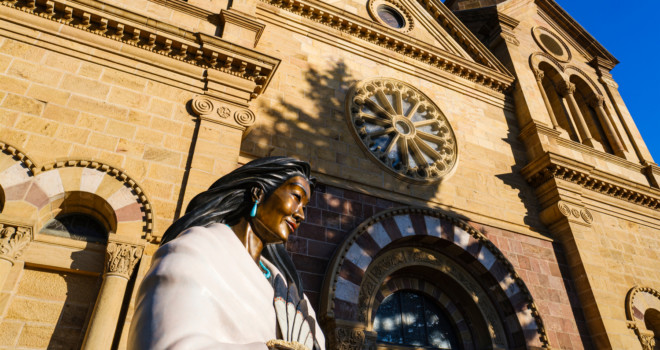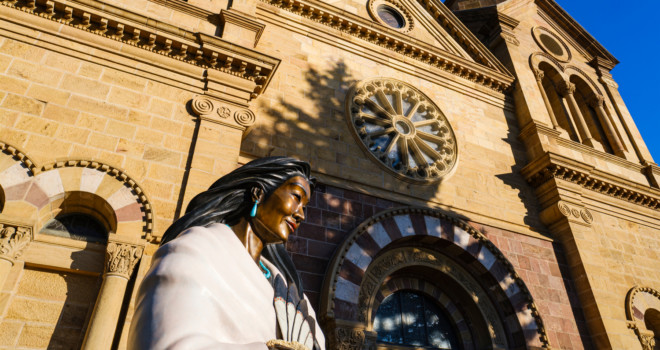With the United States being a relatively young country compared with the traditionally Catholic nations, there are very few canonized U.S. saints, especially considering the total number of saints in Church history to be over ten thousand. Through the end of the twentieth century, there had only been eleven canonizations of people who were born, died, or spent significant time in the United States (or in the territories that were to someday become the United States).
From New York to Hawaii, below is the short list of American saints:
Saint Isaac Jogues & the North American Martyrs
French Jesuit missionaries and martyrs, they ministered among the Iroquois, Huron, and other Native populations in North America. The North American Martyrs, which consisted of St. Isaac Jogues (1646), St. René Goupil (1642), St. Jean de Lalande (1646), St. Antoine Daniel (1648), St. Jean de Brébeuf (1649), St. Noël Chabanel (1649), St. Charles Garnier (1649), and St. Gabriel Lalemant (1649), were canonized in 1930 by Pope Pius XI. Their feast day is October 18.
Saint Kateri Tekakwitha (1656–April 17, 1680)
Known as the “Lily of the Mohawks,” the Algonquin-Mohawk laywoman was born in Ossernenon, a Mohawk village near present-day Auriesville, New York. After converting to Catholicism and taking a vow of perpetual virginity, St. Kateri moved to a Jesuit mission in Quebec. She was the first Native American to be canonized, in 2012, by Pope Benedict XVI. Her feast day is July 14.
Saint Junípero Serra, O.F.M. (November 24, 1713–August 28, 1784)
Born in Majorca, Spain and arriving in Mexico in 1749, the founder of the first nine of twenty-one missions spanning from San Diego to San Francisco earned himself the title of the “Apostle of California.” He was the first person canonized on American soil, in 2015, at the Basilica of the National Shrine of the Immaculate Conception by Pope Francis. His feast day is July 1.
Saint Rose Philippine Duchesne (August 29, 1769–November 18, 1852)
An early member of the Religious Sisters of the Sacred Heart of Jesus, she was a French religious sister who taught and served the people on the Western frontier of the United States and died in Missouri. She was canonized in 1988 by Pope John Paul II, and her feast day is November 18.
Saint Elizabeth Ann Seton (August 28, 1774–January 4, 1821)
The first saint born in what is now the United States, she became known as a founder of the country’s parochial school system, establishing the nation’s first girls’ school in Emmitsburg, Maryland. She also started the first American congregation of religious sisters, the Sisters of Charity. She was canonized in 1975 by Pope Paul VI, and her feast day is January 4.
Saint Théodore Guérin (October 2, 1798–May 14, 1856)
Foundress of the Sisters of Providence of St. Mary of the Woods, she was a French religious sister who founded numerous schools in Indiana and eastern Illinois and is known for her care of the orphaned, the sick, and the poor. Pope Benedict XVI canonized her in 2006, and her feast day is October 3.
Saint John Neumann (March 28, 1811–January 5, 1860)
Immigrating from Bohemia as a priest in 1836, he became the fourth bishop of Philadelphia and is known as the founder of diocesan school systems in the United States. He became the first male saint from the United States, canonized by Pope Paul VI in 1977. His feast day is January 5.
Saint Damien de Veuster (January 3, 1840–April 15, 1889)
Known simply as Fr. Damien, as a missionary priest he ministered for eleven years to the leper colony on the Hawaiian island of Molokai. The Apostle of the Lepers cared for the patients and worked with the community to build houses, schools, roads, hospitals, and churches. He was canonized in 2009 by Pope Benedict XVI, and his feast day is May 10.
Saint Frances Xavier Cabrini (July 15, 1850–December 22, 1917)
The patroness of immigrants and refugees, Mother Cabrini was the first American citizen to be made a saint. An Italian immigrant, she founded the Missionary Sisters of the Sacred Heart of Jesus, a religious institute that was a major support to her fellow Italian immigrants to the United States. She died in Chicago and was canonized in 1946 by Pope Pius XII. Her feast day is November 13.
Saint Marianne Cope, O.S.F. (January 23, 1838–August 9, 1918)
A German religious sister who was a member of the Sisters of St. Francis of Syracuse, New York, she was a missionary with six other sisters who ministered starting in 1883 to leprosy patients on the island of Molokai in Hawaii. St. Marianne Cope was canonized in 2012 by Pope Benedict XVI, and her feast day is January 23.
Saint Katharine Drexel (November 26, 1858–March 3, 1955)
Born in Philadelphia, she was an heiress, philanthropist, educator, and foundress (and superior) of the Sisters of the Blessed Sacrament, ministering to both African Americans and Native Americans. She was canonized in 2000 by Pope John Paul II and has her feast day on March 3.
With the large number of current servants of God (and more added each year) and numerous other active causes for American venerables and blesseds, the number of saints in the States will surely be on the rise in the years and decades to come. In the meantime, the short saint list provides the faithful with a strong set of intercessors and models from whom to seek inspiration.
Recently Approved Miracles

From 2000 to 2020, nine miracles have been approved by the Vatican in American sainthood causes:
2000
Pope John Paul II approved the promulgation of a decree from the Congregation for the Causes of Saints that two-year-old Amy Wall was miraculously healed in 1994 of nerve deafness in both ears through the intercession of St. Katharine Drexel (1858–1955), which lead to her canonization.
2004
After receiving the unanimous affirmation from the Congregation for the Causes of Saints, Pope John Paul II approved as a miracle a 1992 medical cure that involved Kate Mahoney, a fourteen-year-old New York girl who recovered from multiple organ failure after friends and family prayed with a relic for the intercession of St. Marianne Cope (1838–1918).
2006
Pope Benedict XVI approved the promulgation of the decree that the 2001 cure of the failing eyesight of an Indiana man, Phil McCord, through the intercession of St. Théodore Guérin (1798–1856), was indeed a miracle.
2008
The miraculous recovery in 1999 through the intercession of St. Damien of Molokai (1840–1889) of Audrey Toguchi, a Hawaiian woman with metastasized liposarcoma, a terminal cancer that arises in fat cells, was approved by Pope Benedict XVI.
2011
Pope Benedict XVI signed and approved the promulgation of the decree of a miracle received by Sharon Smith, a sixty-five-year-old woman from Chittenango, New York, who was healed from pancreatitis in 2005 through the intercession of St. Marianne Cope (1838–1918).
2011
Pope Benedict XVI approved the second miracle needed for the canonization of Kateri Tekakwitha (1656– 1680) when Jake Finkbonner, a young boy in Washington state, survived a severe flesh-eating bacterium in 2006.
2013
Pope Francis approved the attribution of miraculous restoration in 1963 of perfect vision to an eight-year-old boy, Michael Mencer, who had gone legally blind because of macular degeneration, through the intercession of Bl. Miriam Teresa Demjanovich (1901–1927).
2017
The Congregation for the Causes of Saints and Pope Francis approved a miracle involving the 2012 cure of Paula Medina Zarate of Panama from ichthyosis, a genetic skin condition, attributed to Bl. Solanus Casey, which led to his beatification that took place at Ford Field in Detroit in front of an estimated crowd of sixty thousand.
2020
The miraculous cure from fetal hydrops — an uncommon, typically fatal condition where fluid builds up around the vital organs of an unborn child — attributed to the intercession of Bl. Michael McGivney was approved by the Congregation for the Causes of Saints and authorized by Pope Francis.
✠
Editor’s note: This article is adapted from a chapter in Michael O’Neil’s book They Might Be Saints: On the Path to Sainthood in America. It is available as a paperback or ebook from your favorite bookseller or online through Sophia Institute Press.
Check out Mr. O’Neil’s interview with our editor, Michael Lichens, who discusses the life and influence of Bl. Carlo Acutis on his podcast, The Miracle Hunter.
image: statue of Kateri Tekakwitha outside the Cathedral Basilica of St. Francis of Assisi (Santa Fe), photo by Fotoluminate LLC / Shutterstock













